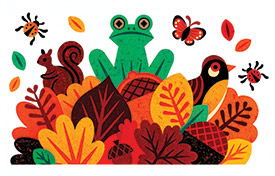Restoration: Less can be more

Illustration by Chanelle Nibbelink
Restoration — assisting in ecosystem recovery — is a key part of the Nature Conservancy of Canada’s (NCC’s) work across the country.
On a large scale, this work helps provide wildlife habitat and increases resiliency to climate change. But small actions can also contribute to the greater good. Read on to learn about how you can help fill in the pieces of the restoration puzzle.
Let it be
Press pause on the yard work and make a difference for Canadian wildlife. In autumn, fallen leaves, as well as plant stalks and seedheads, can provide habitat for small mammals, insects, amphibians and reptiles. Dead tree branches and areas of uncovered soil can be a place for native bees to overwinter. With the time you save, you’ll have lots of opportunity to observe and learn more about the species you encounter, using a field guide or app like iNaturalist.
Back where they belong
Replacing plants with native species and replacing lawns with native ground cover is a great way to contribute to restoration.
Learn about native gardening and select species suited to where you live. Less lawn means more habitat for wildlife. It also means less water, fertilizer, pesticides and herbicides. This reduces waste and makes a healthier place for people and wildlife. And if you take care in choosing the right species, you may notice an increase in butterflies, bees and other pollinators when your plants bloom.
This story originally appeared in the fall 2023 issue of the Nature Conservancy of Canada Magazine. To learn more about how you can receive the magazine, click here.



